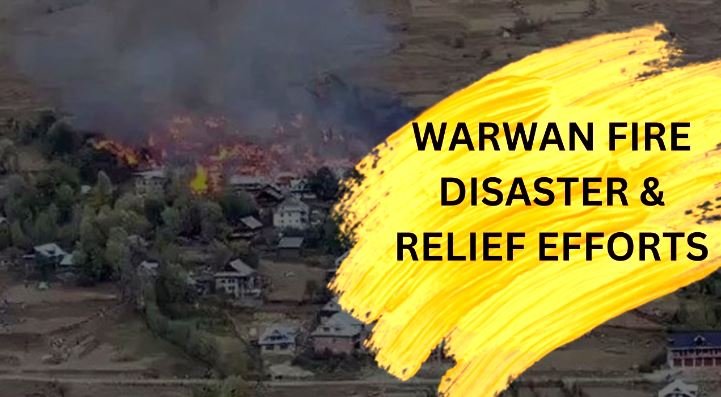In the aftermath of the devastating fire that swept through Mulwarwan village in the Warwan Valley of Kishtwar district, the J&K UT leadership has shown a proactive and compassionate response, signaling its commitment to the affected families. The swift intervention by the Chief Minister and his team is a significant demonstration of a government that not only reacts to crises but also prioritizes sustainable recovery and development for those impacted.
The fire that broke out on October 15 resulted in extensive damage, with dozens of homes reduced to ashes and families left without shelter or basic necessities. For a newly formed government, assuming office on October 16, this incident was an immediate test of its capabilities and resolve. The Chief Minister’s decision to visit the site the next day is a testament to his administration’s commitment to ensuring a hands-on, empathetic approach. This visit, accompanied by senior cabinet members and officials, highlighted the leadership’s intention to assess the situation directly, meet with those affected, and provide both immediate and long-term support. Such actions are vital in building trust with the local population, particularly in remote and vulnerable areas like Warwan. The Chief Minister’s assurance of immediate relief is a crucial step in mitigating the immediate hardships faced by the affected families. With initial aid already provided by the district administration, the Chief Minister’s promise of additional support, including food, clothing, and temporary shelter, is aimed at stabilizing the lives of those impacted. However, the significance of this response extends beyond the immediate relief; it sets the tone for a government that intends to address the root causes of such incidents and work toward lasting solutions. This approach is not only about putting out fires—both literally and figuratively—but also about preventing them in the future. The announcement of housing assistance under the Pradhan Mantri Awas Yojana (PMAY) is a particularly strategic and thoughtful move. The scheme, which aims to provide affordable housing to the underprivileged, is especially pertinent in the context of the Warwan Valley, where the terrain and isolation often impede development efforts. Moreover, the commitment to seeking additional funds through the Prime Minister’s Relief Fund reflects an earnest effort to mobilize all available financial resources for the affected families. The announcement of infrastructure improvements, including the construction of a proper road to the villages, marks a critical long-term solution aimed at enhancing accessibility and mitigating risks. The Warwan Valley, like many remote areas, suffers from inadequate infrastructure, which complicates disaster response efforts and hinders economic development. The construction of roads will not only facilitate access for emergency services, such as fire stations, but also improve connectivity for local residents, enabling better access to markets, healthcare, and education. This dual-purpose infrastructure upgrade aligns with the government’s broader objective of integrating remote communities into the UTs’s economic and social framework, thereby improving overall resilience against future calamities. Additionally, the establishment of two new fire service stations in Warwan and Marwah indicates a forward-thinking approach to disaster management. By setting up these stations, the administration is ensuring that future fires can be addressed swiftly, minimizing damage and safeguarding lives and property. This measure is crucial, as it shifts the focus from merely reacting to disasters to preparing for them, which is a more sustainable and effective approach. Disaster preparedness and awareness programs must become an integral part of the community’s fabric, equipping residents with the knowledge and tools to respond effectively in emergency situations. By investing in these soft measures alongside physical infrastructure, the government can foster a culture of resilience and self-reliance within the community. The Warwan Valley, like much of the Kishtwar district, is characterized by its remoteness and limited economic opportunities. Agriculture and small-scale trades are the primary sources of livelihood, and any disruption, such as a fire, can have devastating consequences for the local economy. By providing not only immediate relief but also sustainable support, the UT leadership is addressing the immediate needs while laying the foundation for long-term development. This dual approach is crucial for transforming the valley’s prospects, as it combines crisis management with development-oriented planning. However, while the government’s efforts are commendable, there is also a need for continuous monitoring and evaluation of these initiatives. It is one thing to announce policies and infrastructure projects; it is another to ensure that they are effectively implemented and reach the intended beneficiaries. The government must establish transparent mechanisms for monitoring the disbursement of relief funds and the progress of infrastructure projects. Regular updates to the public on these developments would not only ensure accountability but also maintain the trust and support of the local population. Engaging with local leaders and community members throughout this process will be vital in adapting solutions to meet the specific needs of the residents effectively.
Finally, the J&K UT’s leadership’s comprehensive response to the Warwan fire disaster demonstrates a proactive and empathetic approach that prioritizes both immediate relief and long-term solutions. Through a combination of financial aid, housing support, infrastructure development, and the establishment of emergency services, the government is addressing the immediate needs of the affected families while laying the groundwork for a more resilient future. This approach, if executed effectively and expanded to other vulnerable areas, could serve as a model for sustainable development and disaster management in the region. The leadership’s focus on integrating central schemes and mobilizing resources reflects a commitment to leveraging all available tools to benefit the local population. However, to ensure lasting success, continuous monitoring, transparent implementation, and collaboration with local communities and external partners will be essential.




